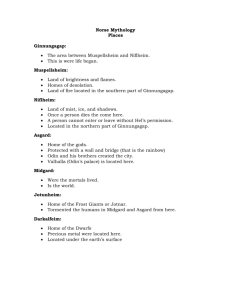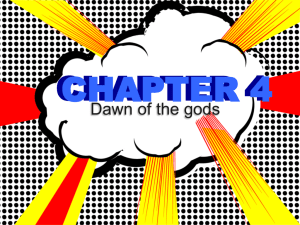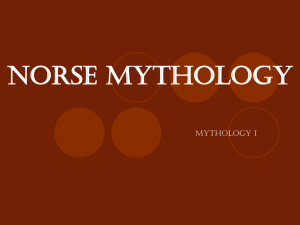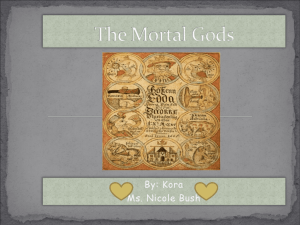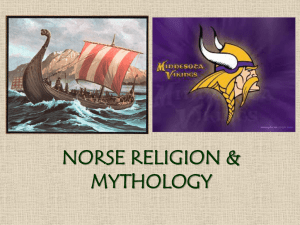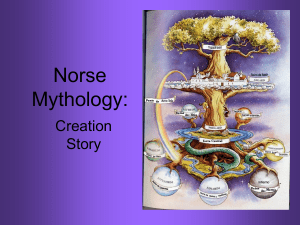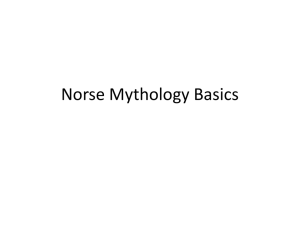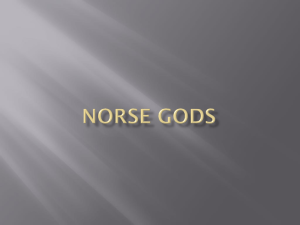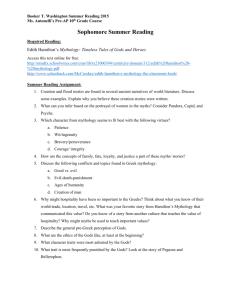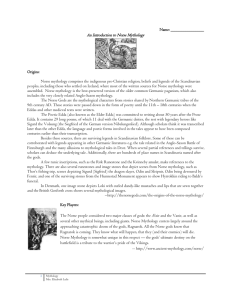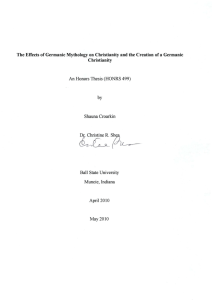Nordic Mythology
advertisement
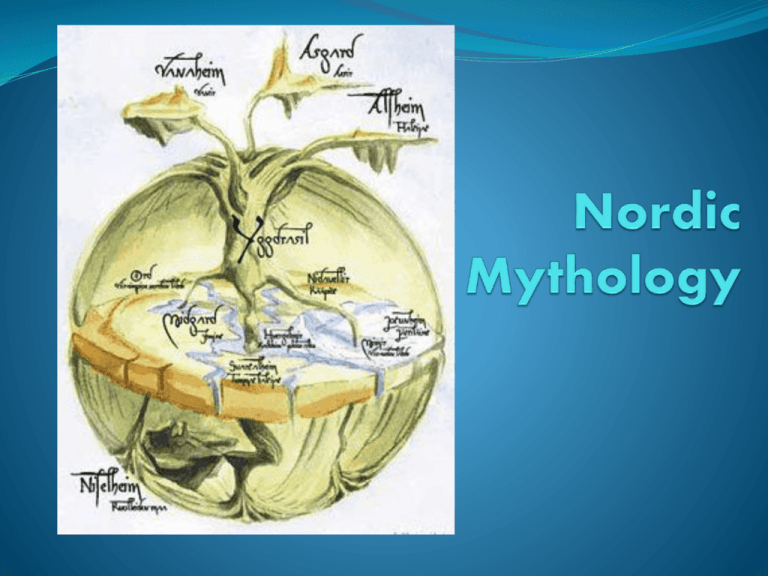
Where did the Norse come from? Nordic Mythology is actually part of oral tradition stemming from Denmark, Sweden, Norway and Iceland. The Norse invaded the British Isles in the form of the Vikings, powerful warriors who sailed out of Norway. The Vikings came to Britain roughly 793 C.E. When the Vikings came to Europe, the roamed the countryside raping, pillaging and burning. Their culture is one of war and destruction, and their gods reflect this. The Basics of Nordic Mythology All Norse mythology is contained in a series of books called the EDDAS. The Poetic, or Elder, Edda was written between 1000 and 1100 CE This work contains the tales of Sigurd and the Creation and Destruction myths The Prose, or Younger, Edda was transcribed in the 1200’s by Snorri Sturluson It contains information about the Norse deities as well as instructions on how to become a poet In the beginning… According to the Eddas, two places existed before the creation of life: Muspelheim, or “World’s End,” and Niflheim, or “Dark World.” Muspelheim was a fiery region to the south Niflheim was an arctic region to the north Between Muspelheim and Niflheim was a void called Ginnungagap, where Muspelheim and Niflheim collide, congeal, and create life. The first being created was a frost giant named Ymir, who was joined by a cow named Audhumla. And then… From Ymir’s armpits are born three beings, and then the giant Buri is released from Niflheim after Audhumla licks him free. Buri creates two giants, Bor and Bestla, who give birth to Odin, Ve and Vili Odin grows to manhood and slays Ymir and becomes father of the gods, and creates the earth from Ymir’s body and the sky from his skull. Odin then creates the first humans from logs he finds on the beach, and names them Ask (ash) and Embla (elm) The Norse World A giant tree supports the entire Norse world. It is called Yggdrasil. It has 3 roots: One grows to Niflheim One grows to Asgard, where the gods live And one goes to Jotunheim, the land of the giants. The 3 Norn sisters live at the base of the tree and control past, present and future The Midgard Serpent circles the base of the tree, gnawing at its root in the hope it can bring the tree down. And in the end… The Norse believed the end of the world would come when the giants decide to attack the gods. This great battle would be known as Ragnarok. To prepare for Ragnarok, the Valkyries, lead by the goddess Freya, train the souls of the dead for battle. The training is done in a remote location known as Valhalla. Ragnarok is the only complete destruction myth. It tells how the majority of the gods and goddesses will be destroyed, and the earth itself consumed in flame. One man and one woman will be saved within Yggdrasil to restart the human race. Valhalla Hall of the Slain A majestic, enormous hall located in Asgard Ruled over by Odin Half of the dead warriors travel here to prepare to assist Odin in Ragnarok Heaven of the Vikings Wounds healed quickly and meat was readily available Gods and Lesser Deities In addition to the main gods, there were two other major players within Nordic mythology: The dwarves. They lived beneath the mountains and were skilled craftsmen. The Vanir. These were demi-gods who controlled the elements and assisted the primary gods. Odin Had his palace in Asgard, where he kept watch over all the doings of both god and Man His two ravens, Hugin and Munin (thought and memory) served as his messengers. Odin’s preferred beverage of choice was wine, which was both food and drink. He is the god of Death, Poetry and Wisdom His wife is Frigg. He lost his eye when he traded it for a drink from the spring of clairvoyance. Germanic spelling of his name is “Woden” from which we get “Wednesday.” Thor Tall, strong, red-bearded, good natured god Thor’s hammer had the ability to be thrown and then come back to him like a boomerang. He is Odin’s oldest son. He is the god of thunder, lightening and agriculture. He is the most popular Norse god. His name is where “Thursday” comes from. Frigg Is the Mother-Goddess, and ruler of the sky and clouds She does not live with her husband, Odin. She lives in a home of her own where she weaves the clouds. Frigg’s tears are said to be the berries of the mistletoe, which killed her son Balder – When he is restored to life, she hangs mistletoe and promises to kiss all who walk beneath it. Her name is the source of “Friday.” Freya She is a lesser goddess, but her importance comes from her responsibility to train warriors for Ragnarok. She is the leader of the Valkyries. She is the most beautiful of the goddesses. Before the advent of Christianity, she was known as the goddess of sexual freedom, fertility and love. Has an amber necklace which grants love to the wearer. Loki Known as the supreme trickster. He causes problems among the gods, and then takes delight in being the one who resolves them. He will be the one to trigger Ragnarok because he is tired of being mistreated by the other gods. He causes the death of Balder, which causes the initial fight between Loki and the rest of the gods. Hel Hel is Loki’s daughter and goddess of the underworld Odin is the one who puts her there, and says she will be the one who presides over those who die from sickness and old age. Norse hell is a freezing river filled with blocks of ice and weapons. She is depicted as half living and half dead. It is from her name that the modern word “hell” comes. Fenrir Will be responsible for the death of Odin during Ragnarok. Is the youngest son of Loki, and the only one not banished by Odin. He bites off the hand of the god Tyr when the other gods attempt to bind him. The chain which binds Fenrir is said to be made from: The sound of a cat's footfall The beard of a woman The roots of a mountain The sinews of a bear The breath of a fish The spittle of a bird Which is why these things no longer exist! Works Cited Branston, Brian. Gods of the North. New York: Thames and Hudson, 1955. Davis, Kenneth C. Don’t Know Much About Mythology. New York: Harper Press, 2005. Hosford, Dorothy. Thunder of the Gods. New York: Holt, Reinhardt and Winston, 1968. Polome, Edgar. Germanic Religion and Mythology. Encyclopedia Britannica Inc. 2009. <www.history.com>. “Prinicple Gods of Norse Mythology.” Encyclopedia Mythica. 24 January 2008.
